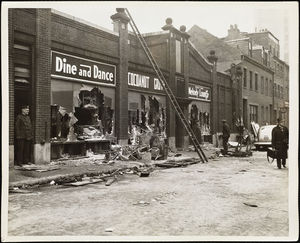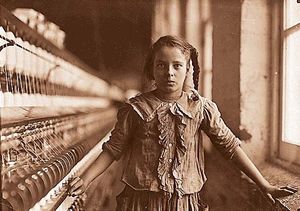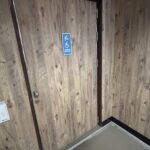There have been many fires throughout history that have shaped our current codes, and I recently ran across a series in the Enid (Oklahoma) News which includes several events that impacted the door and hardware industry specifically. As I’ve said before, I think we can learn a lot from the past – I talk about some of these tragedies in my Decoded series (Class #3 is this week!) as a way to remind us all why codes exist.
If you can make a little extra time today, these are worth reading:
‘Absolutely Fireproof’: Iroquois Theatre blaze kills more than 600 – Enid News
 Many theatergoers were attempting to flee and some found the fire exits behind draperies, but were unable to operate the bacule, or counterbalanced locks.
Many theatergoers were attempting to flee and some found the fire exits behind draperies, but were unable to operate the bacule, or counterbalanced locks.
Three doors to the theater were opened but the majority could not be opened. Patrons began trampling one another in an attempt to escape the flames.
Some were killed while trapped in dead ends or while attempting to open windows designed to look like doors. As performers and stagehands fled through the back of the theater, the wind rushed in and caused the fire to quickly grow larger.
Some escaped through the coal hatch and others through windows. Actors and stagehands became jammed at an inward opening door, which was removed at the hinges by a passing railroad worker carrying tools.
Freight doors, normally used for scenery, also were opened, causing air to again rush in and resulting in a fireball, according to reports from the time.
Patrons who escaped on the north side of the theater found themselves on unfinished fire escapes. Some jumped to their deaths and others fell.
~~~
Cocoanut Grove fire in 1942 killed 492 – Enid News
 “Persons attempting to pass through the exits were overcome by the great heat of fire and of the gaseous material pouring through them at the time,” according to the 1970 report. “The fire, within five minutes after it was first seen in the basement room, entirely traversed the street floor of the main building and had passed to the entrance to the Broadway Lounge.”
“Persons attempting to pass through the exits were overcome by the great heat of fire and of the gaseous material pouring through them at the time,” according to the 1970 report. “The fire, within five minutes after it was first seen in the basement room, entirely traversed the street floor of the main building and had passed to the entrance to the Broadway Lounge.”
According to a National Fire Protection Association synopsis of the Cocoanut Grove fire, all of the hazards at the club were addressed by the 1942 edition of the “Building Exits Code.”
“The main problems appear to have been the chaotic condition of Boston’s building regulations and lax enforcement.”
One of the biggest problems with the club were the exits that were locked, or otherwise hidden from the public by false walls, or painted and draped for intended use by staff.
The 1942 edition of the “Building Exits Code” prohibited revolving doors as exits in places of assembly, and required those that use revolving doors to have swinging doors immediately adjacent or within 20 feet.
According to the NFPA, there were few “new” lessons to be learned from the Cocoanut Grove fire. The danger of locked, blocked and concealed exits already was known.
~~~
Christmas tragedy: The Babb’s Switch fire – Enid News
 Though the fire took a relatively small number of lives compared to other historic conflagrations, the Babb’s Switch fire is known for the large number of poor safety conditions that contributed to the disaster.
Though the fire took a relatively small number of lives compared to other historic conflagrations, the Babb’s Switch fire is known for the large number of poor safety conditions that contributed to the disaster.
Thirty-six people were killed, dozens more were injured and one person was declared missing — and never found — in the fire at Babb’s Switch School, which was located a few miles south of Hobart. The blaze killed entire families that had gathered to celebrate Christmas at the school.
Enid Fire Department Fire Marshal Ken Helms said, “Everything that could go wrong did.”
A Christmas program at the school drew some 200 people to the one-room schoolhouse. The Christmas tree was decorated with candles, and the floors recently had been repainted using a turpentine thinner in expectation of the night’s guests.
While passing out gifts, Santa Claus knocked a candle off the tree and started a fire, which quickly spread.
A spate of vandalism resulted in steel mesh previously having been placed over the school’s windows. The school’s door opened inward, making quick exit difficult, if not impossible.
Some reports from the time said the school had been freshly painted for visiting parents, with turpentine used as paint thinner.
Once someone yelled “fire,” a surge toward the main exit resulted in men, women and children being crushed at the door.
~~~
Deadliest: NYC’s Triangle Shirtwaist fire – Enid News
 Labor laws at the time required doors to open outward, if practical, according to the NFPA. The architect claimed the design was not practical in the Asch Building because the landing was only one stair width from the door. All doors had to open inward.
Labor laws at the time required doors to open outward, if practical, according to the NFPA. The architect claimed the design was not practical in the Asch Building because the landing was only one stair width from the door. All doors had to open inward.
Laws also required factory doors be kept unlocked during the workday.
Doors at the Triangle company reportedly were usually locked during the workday, according to the NFPA. The doors were kept locked to prevent workers from taking breaks or stealing materials from the factory.
Cutaway materials regularly accumulated on the factory floors.
“When last collected, an accumulation of 2,252 pounds of rags had been removed,” according to an NFPA report on the fire. “At the time of the fire, the rags had not been removed for about two months.”
Workers also were crowded together, working at long tables stretching the length of the factory floors.
“Aisles leading to exits were narrow and obstructed,” according to the NFPA report. “Partitions were placed in front of doors and elevators.”
In 1909, a fire insurance inspector recommended the factory doors be kept unlocked during the workday and the company conduct fire drills. The owners took no action on the recommendations.
You need to login or register to bookmark/favorite this content.





Heard about this one today
Rhoads Opera House fire
http://www.thebuildingcodeforum.com/forum/off-topic-posts/16084-rhoads-opera-house-fire.html
Thanks Charles. I read about that one last week too. http://www.insurancejournal.com/news/east/2008/01/15/86413.htm
https://www.youtube.com/watch?v=mNIJ1ToOHtg